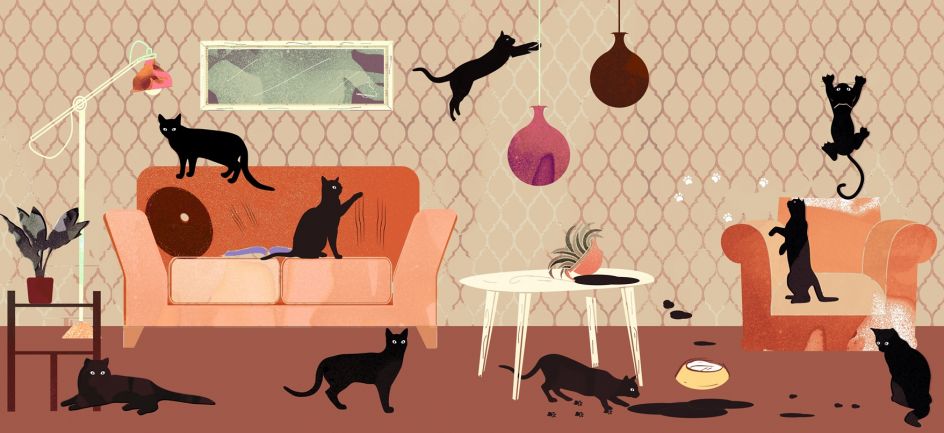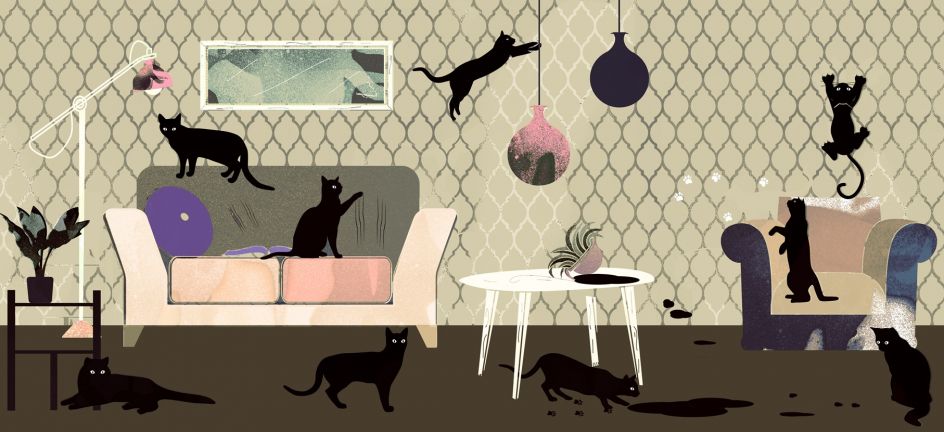It's finally up on the wall - your beautiful new wallpaper, a feast for eyes and senses. But the happiness doesn't last long, as Puss and Fido have also discovered their love for the new wall décor and have had a good go at it. Obviously, the claw marks and rips drive Mummy and Daddy mad...
Many pet owners are only too familiar with this scenario, and the topic is hotly discussed in countless internet forums. It goes without saying that it is more than a bit upsetting if the new wallpaper with the gorgeous pattern hangs off the wall in shreds, and nobody has the money, time or inclination to go through the whole process repeatedly throughout the year.
Which wallpaper types are best suited for pet owners' homes, and are they really the best solution for your wall décor? Let's take a closer look. First things first: the ultimate wallpaper that is dog- or cat-proof does not exist, just as there is no panacea for scratching behaviour, as scratching is a natural behaviour, especially for cats. But dogs and cats don't have to use your lovely new wallpaper to follow that instinct! Like with so many other things in life, it is important to analyse the reasons and react accordingly. The unwelcome scratching and ripping will soon be a thing of the past, as the animals are adaptive, but the onus is on the pet owner to be vigilant.
Reasons why cats and dogs tackle wallpaper
Claw care and marking territory are in the nature of cats and dogs, and they are always on the lookout for suitable surfaces. Keeping claws in check is a natural need which cats follow instinctively. They need surfaces that offer some resistance, and a textured wallpaper could be just the ticket, especially if there are no other options to sharpen claws, or if they are not very suitable for the animal.
Claw marks on wallpaper can also constitute a marking of territory; this is predominantly done by an older cat when new cats are added to the household. These sight/scent notes are set via sebaceous and sweat glands in the paws. There purpose is to signal other cats: “This territory is taken!” Reproductively mature cats often target wallpapers, too.
Other reasons why cats destroy wallpapers are lack of attention and/or boredom. In addition, stress, tension and illnesses can contribute to attacks on wallpaper.
As for dogs, the main reason is usually a lack of attention, insufficient care and a lack of stimulation. Young dogs in particular use wallpaper as a kind of toy.

Determining and eliminating the reasons
In order to be able to determine the underlying reasons why cats and dogs attack wallpapers, we have collated a list of tips and tricks for pet owners below.
Are there any suitable options for scratching/claw maintenance in the room? Experts recommend a separate scratching post for each cat. These are ideal as cats can stand on their hind legs - the same behaviour they will display when scratching wallpaper. The scratching post needs to be absolutely stable; if it is wobbly or even falls over, the cat will soon be back to finding other objects. Cats are keen to be able to have a fairly complete view of their environment, which is why the scratching post should be placed where the cat can observe the room.
If a cat starts “working on” the wallpaper shortly after another cat arrives, it can most probably be put down to marking behaviour.
Let's now look closer at stress factors, boredom and attention deficits. For instance, if cats tackle the wallpaper in front of their owners in a seemingly provocative manner, they are simply looking for attention. The right reaction is essential here. If you just chase the cat away from the wallpaper, the scenario will be repeated, as the animal has reached its goal - one way or another. It'd be preferable to ignore the cat's behaviour and instead lure it to the scratching post, perhaps with a cat treat, and to praise and shower it with attention if it does indeed use the scratching post to sharpen its claws. A little patience is needed to give the cat a chance to fully understand the changes in its environment and treatment.
Try and observe whether the cat tackles the wallpaper when it is scared or under stress, e.g. when the environment is very noisy or strangers are in the house.
If the wallpaper has been damaged when you return after a long day at work, boredom and a lack of distraction might be the cause of your cat “altering” your lovely wallpaper. Challenging and entertaining cat toys are readily available in pet stores, and it might certainly be a good idea to give them a try.

Dogs, too, use wallpaper to let off steam due to being bored- or simply to get your attention. However, this behaviour in dogs could also mask deeper training issues or even illnesses. The reasons need to be determined on an individual basis.
We won't get into too much detail in terms of counter measures to protect your wallpapers at this point, as there are countless forums for dog and cat owners on the internet that will provide you with useful tips and tricks regarding this matter. However, experience tells us that many of the “solutions” depend on a bit of luck and will not work for every single cat or dog. Other potential measures like perspex panelling, sisal mats or scratching boards attached to exposed walls will probably not be an option for connoisseurs of exclusive wall décor. Also, wallpapered areas are occasionally “treated” in a somewhat random manner, which means these options fall by the wayside.
We recommend: Be aware of your pet's needs, as it is your responsibility and not just a cuddly companion. Attention, training and learning processes are important and crucial in order to create and maintain an atmosphere of harmonious co-existence. You can find extensive information about these issues in books or on-line, but specially trained experts (e.g. dog trainers) can also help you. Root cause analysis and solutions are the first step towards flawless wallpaper. Your pet needs to understand that the wallpaper is taboo and that there will be consequences if it doesn't stick to your rules. Point the animal to alternatives and praise or reward it whenever it uses a scratching pole or cat tree.
Wallpaper options for pet owners
We cannot guarantee that our recommendations will work in practice 100%, as unfortunately the phenomenon of scratching wallpaper is simply too complex and unpredictable. But perhaps some of our solutions might work for you and your pet(s).
- Choose wallpapers with smooth surfaces so as to not tempt your animals. Structured surfaces entice cats and dogs to scratching.
- Cats love paper, so it might be useful to try non-woven or vinyl models with smooth or coated surfaces.
- It is a known fact that cats do not like metal surfaces like tin foil. As a consequence, metallic wallpapers could be an option.
- You could consider adding a layer of latex paint to your wallpaper to protect it against scratch attacks. This smooth transparent protective coating also means that the wallpaper is wipeable, which prevents dirt marks and staining.
- Due to their rough surface, wallpapers made from natural fibres like sisal, raffia, linen, jute and various grass types are not suitable for pet owners as they are nothing short of an invitation for your pets to start scratching. Textile wallpapers as well as varieties with glass beads or glitter effects are also unsuitable - for the same reasons.
Notes with regards to cat repellent sprays and essential oils or fragrances for the protection of wallpaper
Pet owners will often be advised to use cat repellent sprays or essential oils to prevent cats and dogs from scratching surfaces. It should be noted that, due to the ingredient composition in these products, they can damage or harm wallpapers. As the name says, scented oils contain oily substances which can leave greasy stains, even when diluted.
The composition of substances and components in repellent sprays is often unclear for laypersons, and coated wallpaper surfaces or those covered with a vinyl layer can be damaged as a result of their application.
If you do consider one of those methods, test the product in an inconspicuous area, e.g. behind a sofa, and wait to see if stains develop. As cats prefer areas close to a door frame because they can use it to hold onto when they stand upright to scratch, it might be an option to use the repellent product on the frame itself - but please be aware that, depending on the material and surface of the frame, this could also lead to staining.



